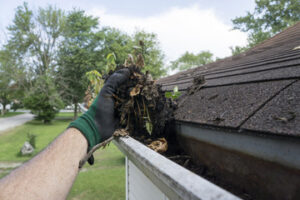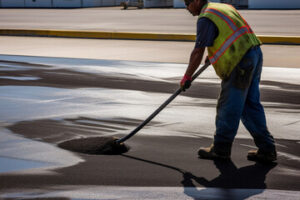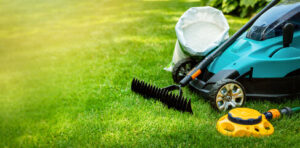Mold isn’t just unsightly; it can be dangerous to your health. Mold spores can trigger allergies and aggravate asthma symptoms, especially in people with pre-existing conditions. They can also cause severe respiratory problems in people with compromised immune systems.

To remove black mold, it’s important to use a chemical cleaner that kills all spores. Some of the best options include hydrogen peroxide and vinegar. Bleach is another effective disinfectant that can be used on non-porous surfaces. Contact Mold Removal Provo for professional help.
Mold is a common problem in homes that can cause a variety of health problems. It can lead to a number of symptoms, including nasal stuffiness, throat irritation and coughing. Black mold is especially dangerous because it can cause serious respiratory issues. Fortunately, there are many natural cleaners that can be used to kill mold and mildew. These products are safer and easier to use than bleach, which can have harmful effects on the body.
White vinegar is a safe, non-toxic alternative to bleach that can be effective at killing mold. Its acidity destroys mold spores, and it can be combined with other household ingredients to create a more effective cleaning solution. Lemon juice is another natural cleaner that can be used to remove mold from surfaces. Its 5% acidity makes it ideal for eliminating mold, and it leaves behind a fresh scent. You can also try adding tea tree oil to the vinegar solution for additional antifungal properties.
Hydrogen peroxide is another powerful antifungal that can be used to clean mold from hard surfaces. To use it, mix equal parts of vinegar and water in a spray bottle and apply the solution to the affected area. Then, wait a few minutes before scrubbing the area with a nylon-bristled brush. After scrubbing, rinse the surface and dry it thoroughly with a cloth.
You can also use baking soda to eliminate mold and mildew. Its antifungal properties make it a great alternative to bleach, which can be difficult to use on porous materials like drywall and carpet. To use it, combine a 1:1 solution of baking soda and vinegar and apply to the affected areas. Then, scrub the area with a brush and rinse with clean water.
When using any chemical cleaner, make sure that you are working in a well-ventilated area and that you wear rubber gloves, eye protection and a face mask to avoid contact with the solution. It is also a good idea to test the cleaner on a small, inconspicuous area before applying it to a larger area. It is also important to address the moisture source that caused the mold growth in the first place, so that it doesn’t reappear. This can be done by repairing any leaks, running a fan and cleaning the area regularly.
Chemical cleaners
Using chemical cleaners as a mold removal method can be effective on some surfaces, but it’s important to use these products with caution. These chemicals can produce toxic fumes that can cause dizziness, nausea, and other health problems. They’re also caustic and can permanently damage surfaces. For this reason, it’s best to hire a professional mold remediation service that uses the latest methods for safe, effective cleaning and deodorizing.
A professional can help you determine the extent of the problem and recommend solutions for preventing future growth. They can inspect all areas of your home, including air ducts and crawl spaces. These hidden areas are prone to mold growth because they often have poor ventilation and insulation. They can also contain leaks and water damage, which can trigger the growth of mold.
Professionals can also identify the underlying causes of mold and address them to prevent recurrence. They can also seal and sanitize the affected area to avoid further contamination and prevent spread of the mold. They will use specialized equipment to clean hard-to-reach places, such as behind walls or under floors.
Mold spores can irritate the respiratory system of people with allergies, asthma, or weakened immune systems. These spores can also damage building materials and lead to structural issues in your home. If you notice signs of a severe mold infestation, it’s essential to call a professional immediately.
There are several types of chemical cleaners that can be used to remove mold from hard surfaces, such as tiles and glass. Bleach and rubbing alcohol are common choices, but they can be dangerous to your health if inhaled for too long.
A more effective way to remove mold is by using a fungicide, which kills the spores and prevents them from growing. This product can be purchased at most hardware stores and is relatively inexpensive. It’s important to test the product on a small area before using it on the entire surface of your home. You should also wear protective equipment when using a chemical cleaner, including rubber gloves and face masks.
Cleaning supplies
Cleaning supplies are essential for mold removal and can be purchased from a local hardware store. When using these products, it’s important to follow proper safety guidelines. When working in a mold-infested area, it’s best to isolate the room as much as possible to prevent the spread of spores throughout the house. This can be done by sealing doors and windows, as well as blocking air vents in the affected rooms. It’s also important to wear a mask and gloves when handling bleach or any other cleaning products.
Bleach is a powerful biocide that can kill mold and mildew and act as a preventative measure. When mixed with water, bleach forms hypochlorous acid, which destroys mold by denaturing proteins and inactivating enzymes. However, it’s not recommended to use bleach on porous surfaces or on a large scale. Bleach can also be toxic to people, and should never be used with ammonia or other household cleaners.
A non-toxic alternative to bleach is hydrogen peroxide, which can be used as an oxidizer and deodorizer in the same way as chlorine bleach. It’s also safe for wood surfaces and is effective against mold growth. Another option is to use an oxygen based cleaner, which uses a combination of hydrogen peroxide and sodium bicarbonate. This is a great choice for hard floors and surfaces, as it’s gentle on the environment.
Mold and mildew can be difficult to remove from some surfaces. Luckily, there are many different types of cleaners on the market that can help you get rid of the problem. There are also specialized mold cleaners that are formulated for specific materials and surfaces. These cleaners are generally more expensive than non-specialized cleaners, but they’re also usually more effective.
There are several different types of mold and mildew removers available, but you should be sure to read the labels carefully before buying one. Look for a product that’s EPA Safer Choice certified, and avoid those that contain hazardous chemicals or irritants. It’s also a good idea to choose a cleaner that comes in a spray form. This will allow you to cover a larger area more quickly.
Hiring a professional
In many cases, a professional mold removal service is necessary to deal with severe problems. These services include scrubbing and cleaning hard surfaces, using detergents and chemicals designed to remove mold spores. They also identify and seal the source of moisture. They can also restore areas that have been damaged by mold and provide proper ventilation.
It is important to remember that mold spores are harmful and can lead to allergies, respiratory issues, and even cancer. Those with pre-existing conditions, such as asthma or a weakened immune system, are more susceptible to serious reactions to exposure. Some types of mold can be toxic, so it is best to hire a professional for any cleanup or removal job.
When hiring a professional, it is important to find one with a good reputation and experience in the field. It is also a good idea to look for one that offers a guarantee on their work. This will ensure that you are getting a quality service. Moreover, it is essential to hire one that will explain how to prevent mold from growing in the future.
A professional will examine the area for mold and other signs of water damage. They will also check for any underlying issues that may have caused the mold, such as leaky pipes or a wet basement. During the mold remediation process, they will also use a wet vacuum pump to remove any remaining moisture and damp air.
They will also test the area for the presence of dangerous mycotoxins, which are toxins produced by certain molds. This test can help determine if the home or business owner is at risk of having a toxic mold problem. This test can also help to pinpoint the type of mold and how extensive the infestation is.
Once they have removed the mold, the professionals will clean and disinfect all surfaces and materials affected by the contamination. This includes drywall, carpeting, and insulation. They will also replace any contaminated items. They will also use a dehumidifier to reduce the moisture levels in the air and prevent mold from returning.





